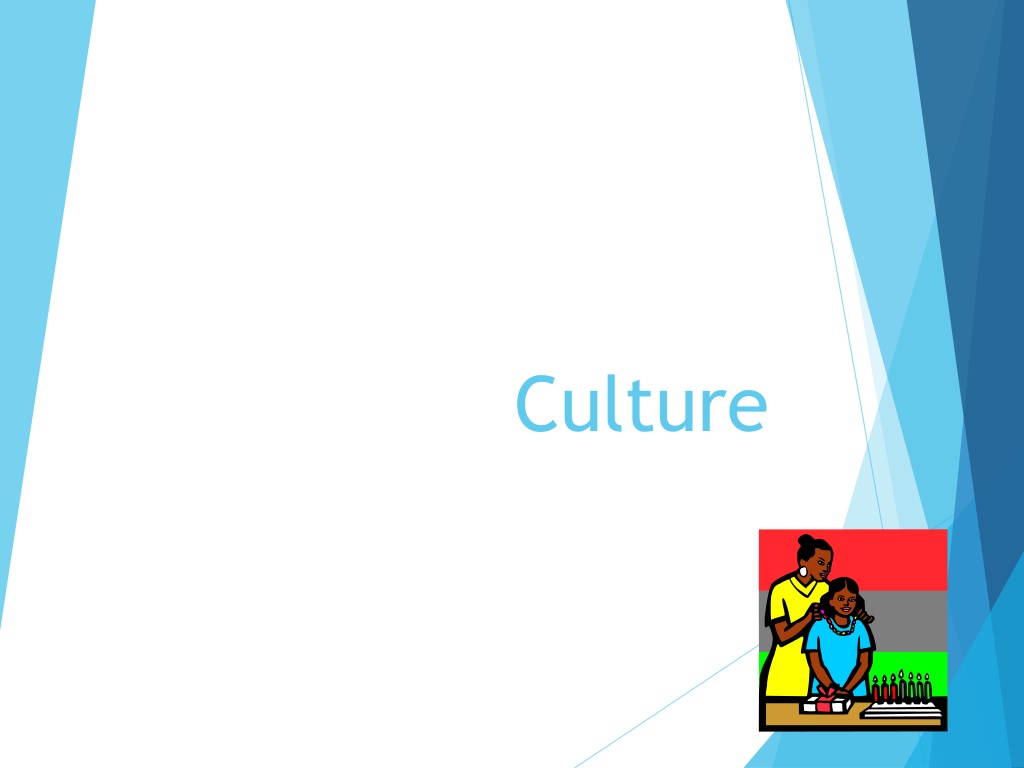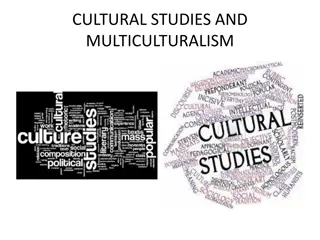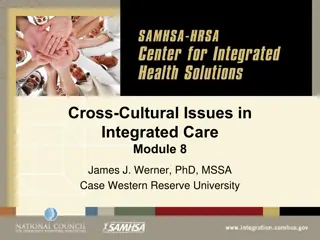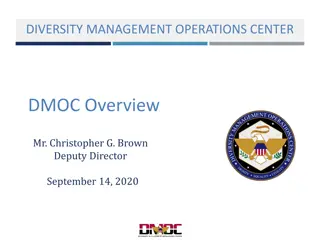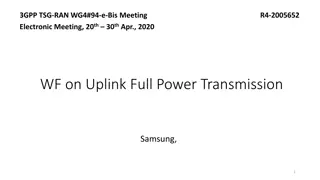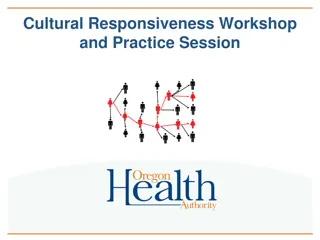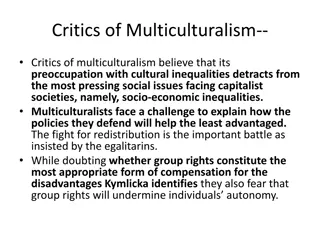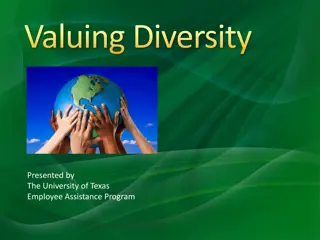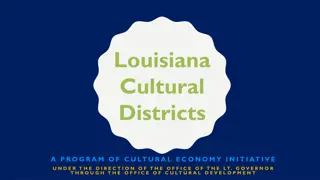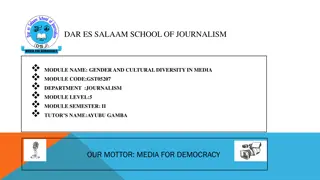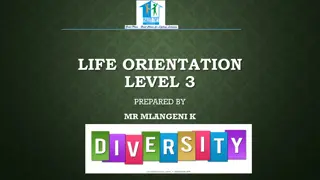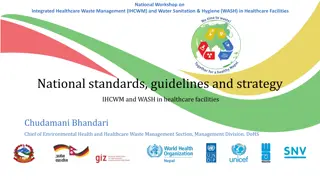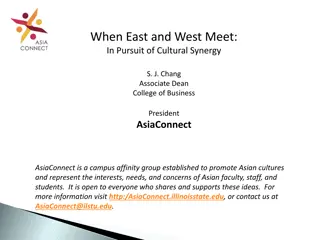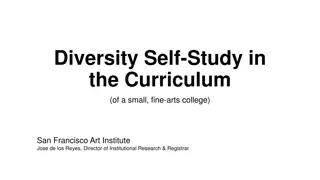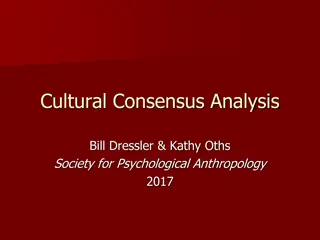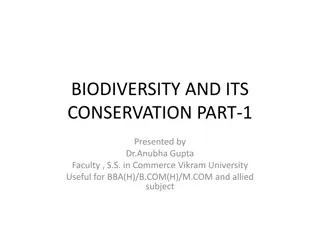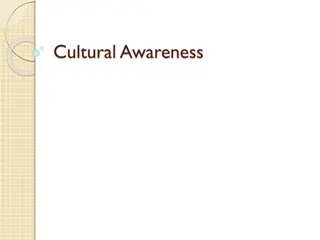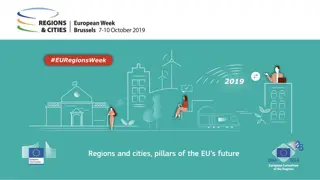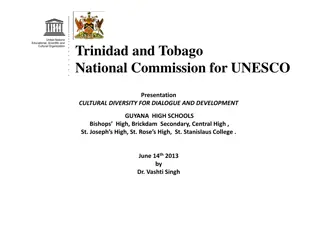Cultural Diversity in Healthcare
The content explores the significance of cultural diversity in healthcare, emphasizing the increasing diversity of the population in the United States and the importance of cultural competence in nursing. It delves into cultural concepts, transcultural nursing, cultural context of health and caring, and cultural healing modalities. Addressing issues like health disparities among ethnic and racial minorities, the material underscores the necessity for healthcare professionals to understand and respect different cultural beliefs and practices to provide effective and compassionate care.
Download Presentation

Please find below an Image/Link to download the presentation.
The content on the website is provided AS IS for your information and personal use only. It may not be sold, licensed, or shared on other websites without obtaining consent from the author.If you encounter any issues during the download, it is possible that the publisher has removed the file from their server.
You are allowed to download the files provided on this website for personal or commercial use, subject to the condition that they are used lawfully. All files are the property of their respective owners.
The content on the website is provided AS IS for your information and personal use only. It may not be sold, licensed, or shared on other websites without obtaining consent from the author.
E N D
Presentation Transcript
Culture 1
Population Diversity The United States is becoming more diverse. Approximately 33% of the population belongs to a racial or ethnic minority group. Figure 9-1 Health disparities among ethnic and racial minorities continue to increase. Eliminating health disparities is one important goal of Healthy People 2010. Racial and ethnic minorities often experience poor access to care 2
Understanding Cultural Concepts Culture Visible Invisible Characteristics: Primary Secondary Subcultures Ethnicity -Race Emic worldview Intercultural Encounter Insider View Etic worldview Intercultural Encounter Outsider View Enculturation Acculturation Assimilation Biculturalism
Cultural Concepts Transcultural Nursing Culturally congruent care Fits the person s valued life patterns and set of meanings Cultural conflicts Culturally competent care Ethnocentrism Requires specific knowledge, skills, and attitudes in the delivery of culturally congruent care. Cultural imposition Ability of nurse to bridge cultural gaps in caring, work with cultural differences, and enable clients/families to achieve meaningful & supportive care. Figure 9-2
Cultural Context of Health and Caring Health, illness, and caring have meanings that are unique to each culture. Every culture provides a context according to which groups interpret and define experiences relevant to life transitions such as birth, illness, and death and religious events Culture provides basis of beliefs of health & illness in terms of cause, dx, healer & treatment. Table 9-1: Comparative Cultural Contexts of Health & Illness
Cultural Healing Modalities & Healers Naturalistic Practitioners Herbs, chemicals, heat, cold, massage & surgery Personalistic Practitioners External agent human or non-human (ghosts) Beliefs Relationship with others (living & deceased) & Dieties Approaches Voodoo Massage, aromatherapy, herbs Nurses need to be familiar with different cultural healers & practices Southeast Asians: Coining, Cupping, pinching, burning 6
Coining Cultural Therapies Cupping 7
Cultural Healing Modalities and Healers: Table 9-2 Chinese and Southeast Asians Herbalist, acupuncturist, fortune teller, shaman Asian Indians Ayurvedic practitioner Native Americans Shaman African American Granny midwife, spiritualist, voodoo practitioner, hougan (male), mambo (female) Hispanics Cuarandero/a, yerbero, sabador, espiritsta, santero/a
Culture Bound Syndrome Culture Bound Syndrome Illness specific to one culture Used to explain personal & social reactions of cultures members 9
Culture and Life Transitions Rights of passage Social markers of changes in a person s life Pregnancy Childbirth Pain verbalization Fear of drug addiction Combination of naturalistic, religious, supernatural modalities combining herbs, massage & prayers Newborn Postpartum period Grief and loss
Cultural Assessment A systematic and comprehensive examination of the cultural care values, beliefs, and practices of individuals, families, and communities Goal: -Gather significant information that will enable the nurse to provide culturally competent care ETHNOHISTORY: significant historical experiences of a particular group. EX: Great Depression (frugal & save). Interpreters: Compatibility: repeats what client said without judgement about content. Dialects of language
Selected Components of Cultural Assessment Ethnic heritage and ethnohistory Biocultural history Health Risks Genetic Disorders: lactose intolerance in Asian-Americans Hypertension in African-Americans Religious and spiritual beliefs Social organization Communication patterns Time orientation Caring beliefs and practices Hispanic: taking turns staying with family member at night Experiences with professional health care
Creative Commons License This work is licensed under a Creative Commons Attribution 4.0 International License. Except where otherwise noted, this content by Southern Regional Technical College is licensed under the Creative Commons Attribution 4.0 International License. To view a copy of this license, click https://creativecommons.org/licenses/by/4.0/ Healthcare Careers Work!(HCW) is sponsored by a $2.3 million grant from the U.S. Department of Labor, Employment & Training Administration. TAACCCT Grant #TC- 26488-14-60-A-13. Southern Regional Technical College is an equal opportunity employer and will make adaptive equipment available to persons with disabilities upon request. This workforce product was funded by a grant awarded by the U.S. Department of Labor s Employment and Training Administration. The product was created by the grantee and does not necessarily reflect the official position of the U.S. Department of Labor. The U.S. Department of Labor makes no guarantees, warranties, or assurances of any kind, express or implied, with respect to such information, including any information on linked sites and including, but not limited to, accuracy of the information or its completeness, timeliness, usefulness, adequacy, continued availability, or ownership.
